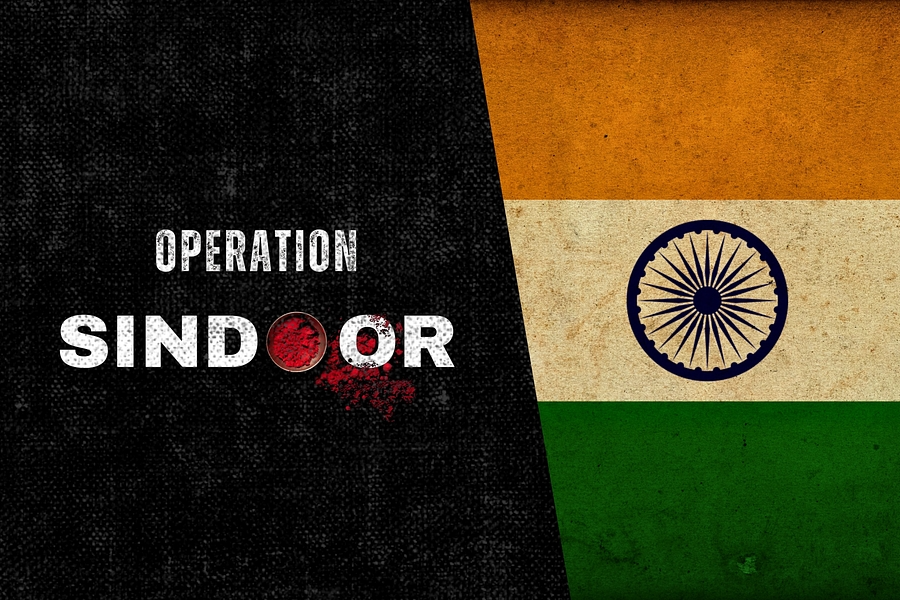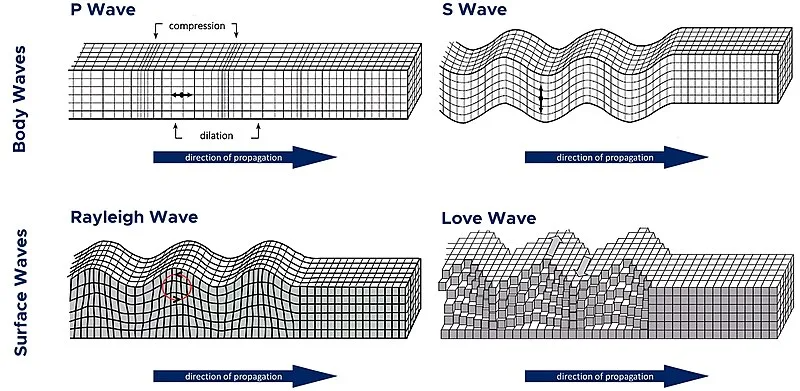September 10th Current Affairs
Table of Contents
NIOS History Textbooks
NIOS History Textbooks NIOS History Secondary NIOS History Senior Secondary
NCERT Sociology Textbooks
NCERT Sociology Textbooks NCERT Sociology for Class-XI (Introducing Sociology) NCERT Sociology for Class-XI (Understanding Society) NCERT Sociology for Class-XII (Indian
NCERT Economy Textbooks
NCERT Economy Textbooks NCERT Economy for Class-IX (Economics) NCERT Economy for Class-X (Understanding Economic Development) NCERT Economy for Class-XI (Indian
NCERT Polity Textbooks
NCERT Polity Textbooks NCERT Polity for Class-VI (Social Science – Social And Political Life – I) NCERT Polity for Class-VII
NCERT Indian Art and Culture Textbooks
NCERT Art and Culture Textbooks NCERT Art and Culture for Class-XI (An Introduction to Indian Art – Part-1) NCERT Art
NCERT Geography Textbooks
NCERT Geography Textbooks NCERT Geography for Class-VI (Social Science – The Earth Our Habitat) NCERT Geography for Class-VII (Social Science
NCERT History Textbooks
NCERT History Textbooks NCERT History for Class-VI (Social Science – Our Pasts-I) NCERT History for Class-VII (Social Science – Social
Kannada Literature Optional Syllabus
Home / ಐಚ್ಚಿಕ ಕನ್ನಡ ಸಾಹಿತ್ಯದ ಪಠ್ಯಕ್ರಮ ಐಚ್ಚಿಕ ಕನ್ನಡ ಸಾಹಿತ್ಯ ಪತ್ರಿಕೆ – 1 ವಿಭಾಗ – ಎ ಅ) ಕನ್ನಡ ಭಾಷೆಯ ಚರಿತ್ರೆ ಭಾಷೆ
UPSC Current Affairs – October 6th
October 06th Current Affairs Home / Table of Contents 36-hour curfew imposed in parts of Odisha’s Cuttack over communal tensions
Religious Minorities in India and the Challenge of Communal Harmony: A Sociological Reflection on the Cuttack Violence
Home / Religious Minorities in India and the Challenge of Communal Harmony: A Sociological Reflection on the Cuttack Violence Sociology
C P Radhakrishnan to be the 15th Vice President of India
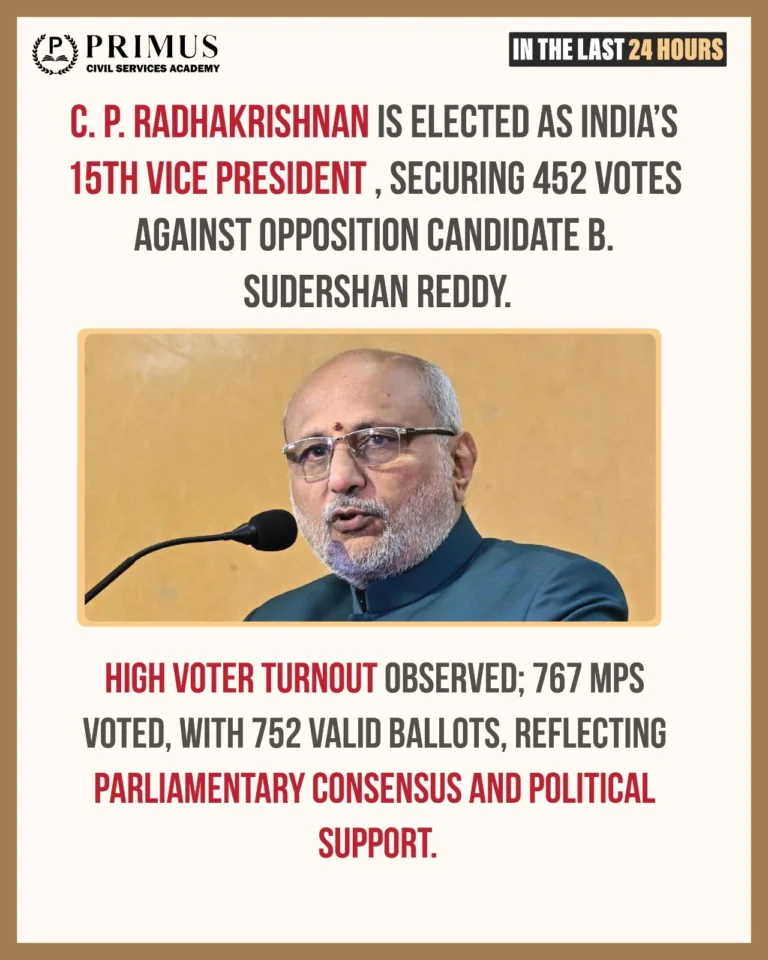
Relevance to UPSC
GS Paper II – Polity & Governance
- Highlights the Vice-President’s election mechanism: indirect election by MPs through proportional representation and single transferable vote.
- Demonstrates constitutional protocol for early elections under Article 68, following VP Jagdeep Dhankhar’s resignation due to health reasons.
- Radhakrishnan’s emphasis on cooperative federalism underlines the importance of Centre-State harmony for democratic resilience and institutional stability.
More About the News
- 15th Vice-President elected: NDA nominee C. P. Radhakrishnan secured 452 votes, defeating opposition’s B. Sudershan Reddy with 300 votes—a margin of 152.
- High turnout, some invalid votes: Of 781 electors, 767 MPs voted; 752 votes were valid while 15 were invalid.
- Ideological & federal focus: Radhakrishnan termed the win a triumph of nationalistic ideology and stressed cooperative federalism.
- Cross-voting & reactions: Speculation over opposition cross-voting arose, though leaders praised his integrity and administrative skills.
Vice President of India
The Vice-President of India is the country’s second-highest constitutional office and the ex-officio Chair of the Rajya Sabha. Over time the office has evolved into a largely presiding and ceremonial role with occasional constitutional functions (acting President, tie-breaking constitutional continuity). Its practical significance lies in parliamentary procedure, custodianship of the upper house and in guaranteeing continuity of the executive when requirements.
Evolution of the Position
- British/US influence → Constitutional adoption (1950s): The idea of a vice-presidential office appears in the Constituent Assembly debates and draws procedural form from bicameral traditions and some US institutional ideas, but adapted for a parliamentary system.
- From occasional acting President → institutionalized Rajya Sabha Chairmanship: Initially conceived mainly as presidential successor; practice emphasised the VP’s role as Rajya Sabha Chairman and custodian of parliamentary procedure.
- Political usage increased: Parties increasingly nominate senior political figures or experienced administrators, making the post a tool for representation and coalition signalling.
Constitutional Provisions
- Article 63 – Office of Vice-President.
- Article 64 – Vice-President is ex-officio Chairman of the Council of States (Rajya Sabha).
- Article 65 – Vice-President to act as President or discharge functions during casual vacancies/absence.
- Article 66 – Election of Vice-President (electoral college of both Houses of Parliament, single transferable vote, secret ballot).
- Article 67–69 – Term of office, filling casual vacancies, oath.
Non-constitutional Provisions & Conventions
- Selection by ruling coalition for political balance / symbolism (convention).
- Role expectations: impartiality while presiding, protect Rajya Sabha’s autonomy (convention and practice).
- Removal procedure practice: resolution in Rajya Sabha followed by Lok Sabha — used rarely (procedural convention).
Roles & Functions
- Ex-officio Chairman of Rajya Sabha — preside, maintain order, refer bills to committees, decide admissibility of motions.
- Acting President — discharges President’s functions during vacancy/absence (Article 65).
- Succession-guarantee — ensures continuity of constitutional authority until President is elected.
- Representative & diplomatic duties — attends functions, state visits, and represents Parliament.
- Impartial arbiter in Rajya Sabha — protects minority rights, ensures parliamentary procedure and decorum.
Advantages of having the position
- Continuity of State — ensures immediate constitutional authority if the President’s office falls vacant (e.g., VP acting as President to avoid power vacuum).
- Parliamentary neutrality & order in Upper House — impartial presiding officer prevents executive overreach in legislative proceedings (example: safeguarding debate procedure in Rajya Sabha).
- Symbolic representation — appointment can reflect regional, social or political balancing (e.g., nomination of leaders from different regions/OBC background to signal inclusivity)
- Institutional memory & statesmanship — experienced VPs can mediate inter-party disputes and advise Parliament (example: respected VPs moderating contentious sessions).
- Checks and continuity in crisis — quick constitutional substitute for President during emergencies or sudden resignation (example: acting President role used to maintain constitutional continuity).
Impacts of the position
- Stability in parliamentary functioning — smooth conduct of Rajya Sabha business (example: orderly passage and scrutiny of legislation).
- Political messaging & coalition dynamics — choice of VP signals central government’s priorities (example: nominating a candidate to reassure an ally or a region).
- Constitutional continuity — prevents institutional vacuum during transitions (example: acting Presidency between resignation and election).
- Legislative oversight — Chair’s rulings shape how debates and amendments proceed, influencing law-making quality.
- Public perception of neutrality of institutions — an impartial VP can reinforce trust in parliamentary procedures; a partisan VP can harm perception. (example: public debate about neutrality after politically prominent nominations).
Disadvantages of Having the Position
- Ceremonial redundancy — overlap with President’s largely ceremonial status in parliamentary system may make VP seem superfluous. (Critique often raised in comparative debates).
- Partisan selection — when VP is an overt political appointee, perceived neutrality can be compromised (example: public criticism when nominees are strongly partisan).
- Limited executive power — critics argue the office lacks substantive powers to act as an effective constitutional check.
- Cost and protocol burden — maintaining high constitutional office entails expense with limited functional output (general administrative critique).
- Potential for politicised Chair rulings — if Chair’s rulings are seen to favour ruling party, it can undermine Rajya Sabha’s role as revising chamber (example: controversy around certain procedural rulings).
Challenges faced by the Vice-President
- Maintaining impartiality — balancing past political identity with need to be neutral as Chair (challenge when nominees are party veterans).
- Managing legislative gridlock — presiding over a fragmented or oppositional Rajya Sabha demands high procedural skill (example: close votes and disruptions).
- Public expectations vs constitutional limits — citizens may expect activist roles the Constitution doesn’t confer.
- Succession pressures in crises — acting President must navigate executive duties under political scrutiny until a new President is elected.
- Protecting the Rajya Sabha’s autonomy — resisting pressures from executive/party leadership to curtail debate or bypass scrutiny.
Way Forward
- Clarify conventions: Publish a parliamentary code of conduct for the Chair to strengthen impartiality norms.
- Capacity building: Professional training for Chair/Secretariat on complex procedural and constitutional issues.
- Transparency in selection: Encourage broader consultation, making choice less partisan and more representative.
- Strengthen Rajya Sabha autonomy: Institutional safeguards for committee referrals and minority rights in the Upper House.
- Periodic review: Parliamentary committee review (e.g., Procedure or Privileges) to recommend procedural reforms for Chair’s role.
The Vice-President will remain a vital constitutional safety valve and the principal guardian of Rajya Sabha procedure. Strengthening conventions, improving transparency in selection and investing in institutional capacity will enhance the office’s democratic value. In the future, a less partisan, more procedure-focused Vice-Presidency can bolster parliamentary quality and constitutional continuity.
Feature | India — Vice-President | USA — Vice-President |
Selection / Election | Elected by both Houses of Parliament (electoral college), using single transferable vote & secret ballot. ([Constitution of India][1]) | Elected on a joint ticket with the President through the Electoral College system. |
Legislative role | Ex-officio Chairman of Rajya Sabha, presiding officer; maintains order and procedure. ([Digital Sansad][3]) | President of the Senate; presides and casts a tie-breaking vote when needed. |
Executive power | Largely ceremonial; acts as President only during a vacancy or absence. ([Constitution of India][1]) | Constitutional successor; also plays active roles in advisory councils, national security, diplomacy. ([UPPCS Magazine][4]) |
Partisan nature | Often a political nominee; expected to act impartially as Rajya Sabha Chair. ([The Times of India][5]) | Strongly political; chosen as a campaign partner, but also given substantive responsibilities. |
Succession | Acts as President temporarily until a new President is elected. ([Constitution of India][1]) | Direct constitutional successor; becomes President if the President dies, resigns, or is removed. |
Prelims MCQ
Q. Which of the following statements about the Vice-President of India is/are correct? 1. He is elected by an electoral college consisting of both elected and nominated members of Parliament. 2. He is a member of Rajya Sabha by virtue of his office 3. He acts as President when a vacancy occurs in the office of the President.
A. 1 and 2 only
B. 1 and 3 only
C. 2 and 3 only
D. 1, 2 and 3
Mains Question
Q. “Critically examine the role of the Vice-President of India as the Chairman of the Rajya Sabha. In your answer, analyse whether the current constitutional design and conventions sufficiently ensure the Vice-President’s impartiality and effectiveness. Suggest reforms to strengthen the office’s contribution to parliamentary democracy.”
Nepal Gen Z Protest, Nepal Army takes control of Kathmandu Airport
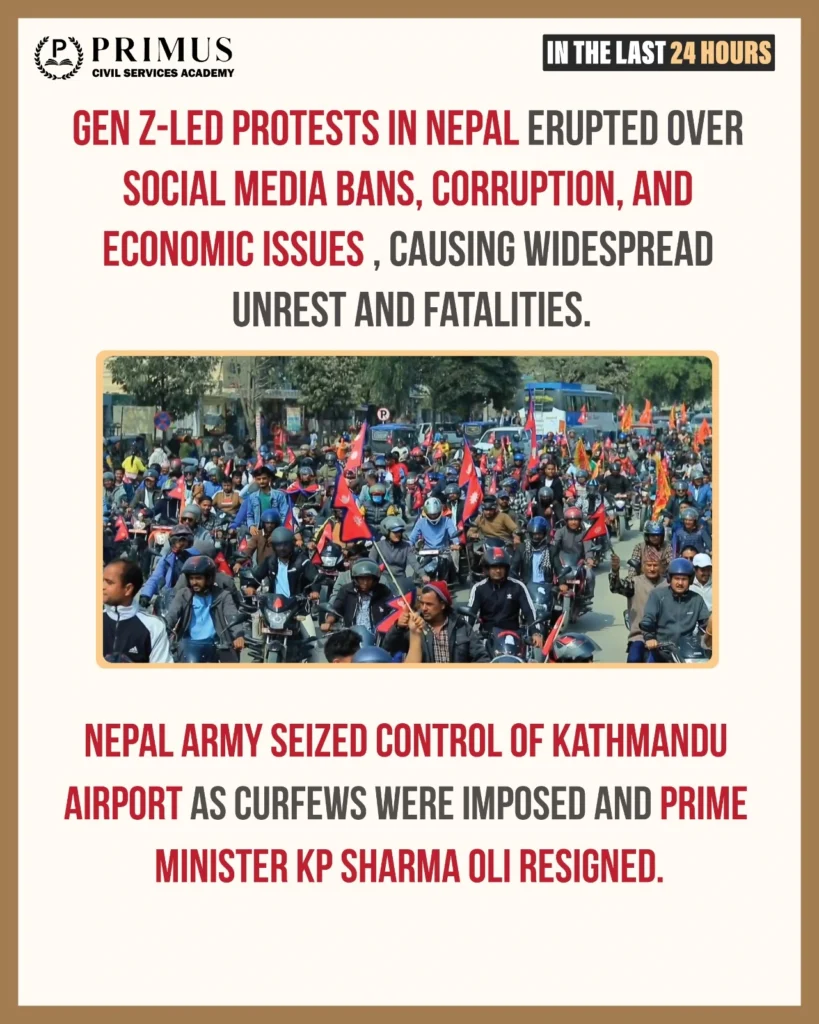
Relevance to UPSC
GS Paper II: India and its Neighbourhood — Relations
- Neighbourhood dynamics & spillover risks: Instability in Nepal, a close neighbour, raises concerns for India regarding cross-border refugee flows, tourism disruptions, and diplomatic engagement—crucial considerations in regional geopolitics.
- Youth activism & digital rights: The Gen Z mobilization underscores the rising role of digital platforms in political dissent and governance; this reflects broader themes of social media regulation versus free expression—central to contemporary polity debates.
GS Paper I: Indian Society
- Youth-led social change: The protests demonstrate how young demographics, especially Gen Z, can reshape political discourse, challenge entrenched structures, and signal a generational shift in demands for transparency and accountability.
- Role of symbolism and pop culture: The use of globally recognized cultural references (like the One Piece flag) to unify protests highlights the influence of global media on identity and collective action.
More About the News
- Youth-led protests: Gen Z mobilized against corruption, unemployment, and a ban on 26 social media apps; clashes with security forces left 19 dead and many injured.
- Government response & fallout: Social media ban reversed, curfew enforced across Kathmandu; escalating unrest forced PM KP Sharma Oli to resign.
- Symbols & regional concerns: Pop culture icons like the One Piece “Straw Hat” flag unified youth protests; Indian tourists stranded, raising cross-border and regional stability issues.
India - Nepal Relations
India and Nepal share a unique relationship characterized by geographical proximity, historical ties, and cultural affinity. Over decades, their bilateral ties have evolved through trade, strategic cooperation, and people-to-people linkages. Strengthening this partnership is crucial for regional stability, economic growth, and strategic interests in South Asia.
Evolution of India–Nepal Relations
- Ancient and cultural ties: Shared Hindu-Buddhist heritage, open borders, and people-to-people contact facilitated centuries of friendly interactions.
- Post-independence era (1947 onward): India recognized Nepal’s sovereignty; both countries signed the 1950 Treaty of Peace and Friendship establishing open borders and trade rights.
- Cold War period: Nepal maintained non-alignment but leaned on India for economic and infrastructural support.
- Post-1990 democratic transition in Nepal: Enhanced political dialogue and Indian aid for democracy-building.
- Recent developments: Focus on infrastructure, hydropower cooperation, and regional connectivity projects under BIMSTEC, BBIN, SAARC frameworks.
Key Trends in Relations
- Increased economic cooperation: Bilateral trade, investments in hydropower and rail-road connectivity.
- Strategic collaboration in security and border management.
- Rising people-to-people exchanges through cultural, educational, and tourism linkages.
- India’s engagement in post-earthquake reconstruction (2015 Nepal earthquake).
- Growing youth and social media-driven political awareness influencing bilateral diplomacy.
Common Membership in International Organisations / Groupings
- SAARC (South Asian Association for Regional Cooperation)
- BIMSTEC (Bay of Bengal Initiative for Multi-Sectoral Technical and Economic Cooperation)
- BBIN (Bangladesh–Bhutan–India–Nepal Motor Vehicles Agreement)
- UN and its specialised agencies (UNESCO, WHO)
- ICIMOD (International Centre for Integrated Mountain Development)
Strengths in India–Nepal Relations
- Open borders & free movement – Citizens can live, work, and trade across borders without visa restrictions; example: border trade towns like Birgunj–Raxaul.
- Economic & developmental support – India funded major projects like the Pokhara International Airport and Post-earthquake reconstruction.
- Hydropower cooperation – Collaboration on projects like West Seti & Budhi Gandaki for mutual energy benefits.
- Cultural and religious ties – Shared festivals, Pashupatinath and Ganga-related pilgrimages enhance goodwill.
- Strategic partnership – Security cooperation, intelligence sharing, and border management help maintain regional stability.
Weaknesses in India–Nepal Relations
- Border disputes – Controversies over Kalapani–Limpiyadhura–Lipulekh regions have caused diplomatic tensions.
- Trade imbalance – Nepal imports far more from India than it exports, leading to dependency.
- Perception of Indian dominance – Some Nepali factions see India as exerting undue influence in politics.
- Political instability in Nepal – Frequent changes in government affect consistency of bilateral agreements.
- Limited people-to-people engagement outside border regions – Urban Nepali youth may feel distant from India-focused projects, reducing soft power effectiveness.
Challenges in India–Nepal Relations
- Geopolitical competition – China’s increasing footprint in Nepal via Belt and Road Initiative (BRI) and infrastructure funding.
- Nationalist sentiments in Nepal – Anti-India rhetoric during political protests (e.g., social media-driven Gen Z protests).
- Climate & natural disasters – Floods, landslides, and earthquakes complicate cross-border aid and infrastructure projects.
- Economic dependency vs. sovereignty concerns – Balancing Indian assistance without undermining Nepal’s autonomy.
- Cross-border security threats – Smuggling, human trafficking, and insurgent movement along open borders.
Initiatives Taken Together
- Treaty of Peace and Friendship (1950, revised 2021) – Open borders, trade, and security cooperation.
- India–Nepal Joint Commission Meetings – Regular dialogue on infrastructure, trade, and water resources.
- Infrastructure projects – PM Modi inaugurated Bharat–Nepal cross-border rail and road projects.
- Hydropower cooperation – Bilateral projects to export power to India and improve Nepal’s energy security.
- Humanitarian assistance – India provided aid during 2015 earthquake, COVID-19 pandemic, and floods.
Way Forward
- Strengthen infrastructure and connectivity, including rail, road, and air links.
- Resolve border disputes through dialogue, respecting sovereignty and international law.
- Promote trade balance via joint industrial parks and export promotion.
- Enhance youth, cultural, and educational exchanges to build soft power.
- Foster multi-level cooperation in disaster management, climate adaptation, and security.
India–Nepal relations are shaped by geography, culture, and shared strategic interests, making them a cornerstone of South Asian stability. Future engagement must balance developmental support with respect for Nepal’s sovereignty. Strengthened economic, cultural, and security partnerships will ensure mutually beneficial and resilient bilateral ties.
Prelims MCQ
Q. Nepal shares its international borders with which of the following countries?
A. India and Bhutan only
B. India, Bhutan, and China
C. India and China only
D. India, China, Bhutan, and Myanmar
Mains Question
Q. “Examine the evolution of India–Nepal relations and discuss the key challenges and opportunities in the bilateral partnership. Suggest measures to strengthen cooperation while balancing Nepal’s sovereignty and regional strategic interests.”
Macron names close ally Sebastien Lecornu as new French PM
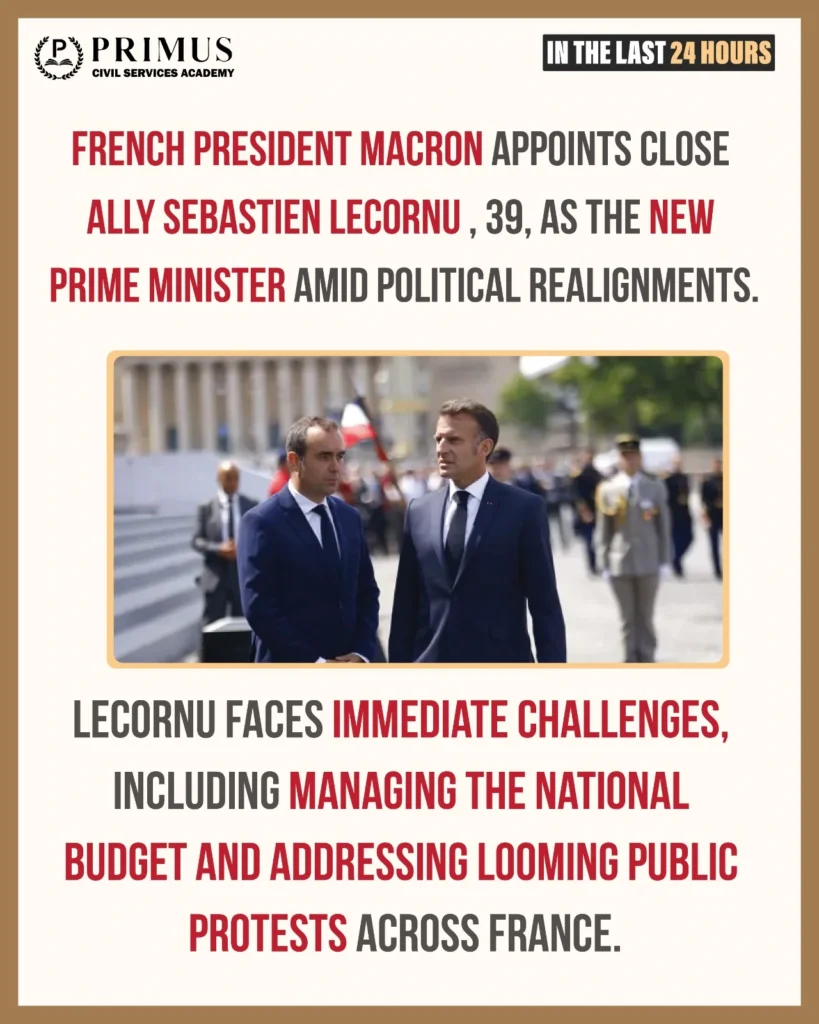
Relevance to UPSC
GS Paper II – Governance & Political Dynamics: Sébastien Lecornu’s appointment as France’s Prime Minister illustrates executive decision-making, political realignment, and mechanisms to ensure government stability in a parliamentary system.
More About the News
- New Prime Minister Appointed: President Emmanuel Macron named Sébastien Lecornu, former Defense Minister, as France’s new Prime Minister following François Bayrou’s resignation after a failed confidence vote.
- Political Challenges Ahead: Lecornu faces significant challenges, including addressing a €51 billion budget deficit and navigating political instability marked by upcoming protests.
- Strategic Appointee: Lecornu’s appointment is seen as a move to maintain continuity in Macron’s pro-business economic agenda, despite potential alienation of the Socialist Party.
Semi -Presidential form of Government
A semi-presidential system combines features of both presidential and parliamentary systems, aiming to balance strong executive leadership with legislative accountability. It typically includes a directly elected president alongside a prime minister responsible to the legislature. This system is increasingly relevant in modern democracies seeking stability, checks on executive power, and flexibility in governance.
Evolution of The Semi-Presidential System
- Origin: First formalized in France’s Fifth Republic (1958) under Charles de Gaulle.
- Spread to other countries: Adopted in post-colonial states and transitional democracies seeking to balance presidential authority with parliamentary oversight.
- Institutionalization: Combines directly elected president (strong executive) with a prime minister and cabinet accountable to legislature.
- Modern adaptation: Countries tweak powers between president and prime minister based on historical, political, and social contexts.
- Purpose: Designed to avoid deadlock seen in pure presidential or parliamentary systems, while maintaining stability.
Countries with Semi-Presidential System
- France
- Portugal
- Finland
- Ukraine
- Taiwan
- Russia (although often debated as “super-presidential” in practice)
How this System Works
- Dual executive: President (directly elected) handles foreign policy, defense, and national security; Prime Minister handles domestic policy and day-to-day governance.
- Accountability: PM and cabinet are accountable to parliament; president may have veto or dissolution powers.
- Power-sharing: Varies based on “cohabitation” — whether president and parliamentary majority belong to same party.
- Legislative oversight: Parliament can remove PM via vote of no-confidence; president usually remains secure.
- Flexibility: System adapts between presidential dominance and parliamentary dominance depending on political configuration.
Advantages of this System
- Balanced governance – Combines strong presidential leadership with parliamentary accountability (e.g., France ensuring stability during crises).
- Checks and balances – Prevents concentration of power in single branch; parliament can restrain PM (e.g., Portugal).
- Flexibility during cohabitation – Allows peaceful power-sharing when president and parliamentary majority differ (e.g., France 1986–1988).
- Direct legitimacy – President elected by people gains mandate, enhancing authority in foreign policy and defense (e.g., Ukraine).
- Political stability – Reduces risk of frequent government collapses while preserving democratic oversight (e.g., Finland).
Disadvantages of this System
- Potential conflict between executives – President vs PM may clash, causing policy paralysis (e.g., France during cohabitation periods).
- Dual accountability confusion – Citizens may be unclear about responsibility for governance issues (e.g., Russia’s blurred executive lines).
- Risk of over-centralized power – Strong presidents may overshadow parliamentary authority (e.g., Ukraine, Russia).
- Complexity in coalition management – PM may face instability if parliament is fragmented.
- Ambiguity in crisis situations – Overlapping powers can delay decision-making during emergencies.
Challenges with this System
- Cohabitation conflicts – Opposition president and parliamentary majority may block each other’s policies.
- Weak party discipline – PM may struggle to pass bills if president interferes or parliament is fragmented.
- Constitutional ambiguity – Vague delineation of powers can trigger judicial disputes.
- Electoral volatility – Direct presidential elections may create populist pressures, undermining cabinet decisions.
- Foreign influence risks – Strong president may pursue foreign policy independently, affecting bilateral relations (e.g., Ukraine–Russia tensions).
Is Semi-Presidential System Present in India?
- No. India follows a parliamentary system with a ceremonial president, not a semi-presidential system.
- President acts largely as constitutional head; Prime Minister and Council of Ministers are responsible to Parliament.
Way Forward
- Clearly define powers of dual executives to avoid conflicts.
- Encourage cooperation between president and parliament through institutional mechanisms.
- Strengthen judicial review for resolving executive-legislature disputes.
- Promote political maturity and party discipline for stable governance.
- Educate citizens on roles of president and PM to reduce accountability confusion.
The semi-presidential system offers a hybrid model balancing strong leadership with parliamentary oversight. Its success depends on clear division of powers, political maturity, and institutional safeguards. Properly implemented, it can enhance stability, legitimacy, and accountability in modern democracies.
Prelims MCQ
Q. Which of the following features is characteristic of a semi-presidential system?
A. The president is only ceremonial and elected by parliament.
B. The prime minister is directly elected and accountable to the president.
C. Both a directly elected president and a prime minister accountable to parliament share executive powers.
D. The system eliminates the parliament in favor of a strong president.
Semi-presidentialism involves dual executive: president (directly elected) and PM (accountable to legislature). Powers are shared between president and cabinet, unlike pure presidential or parliamentary systems. Provides checks and balances to prevent concentration of authority..
Mains Question
Q. “Critically analyse the applicability of the semi-presidential system in India. Could it strengthen governance, or would it create conflicts within the executive?”
Microsoft Mandates 3-Day Work-From-Office For Employees By February 2026
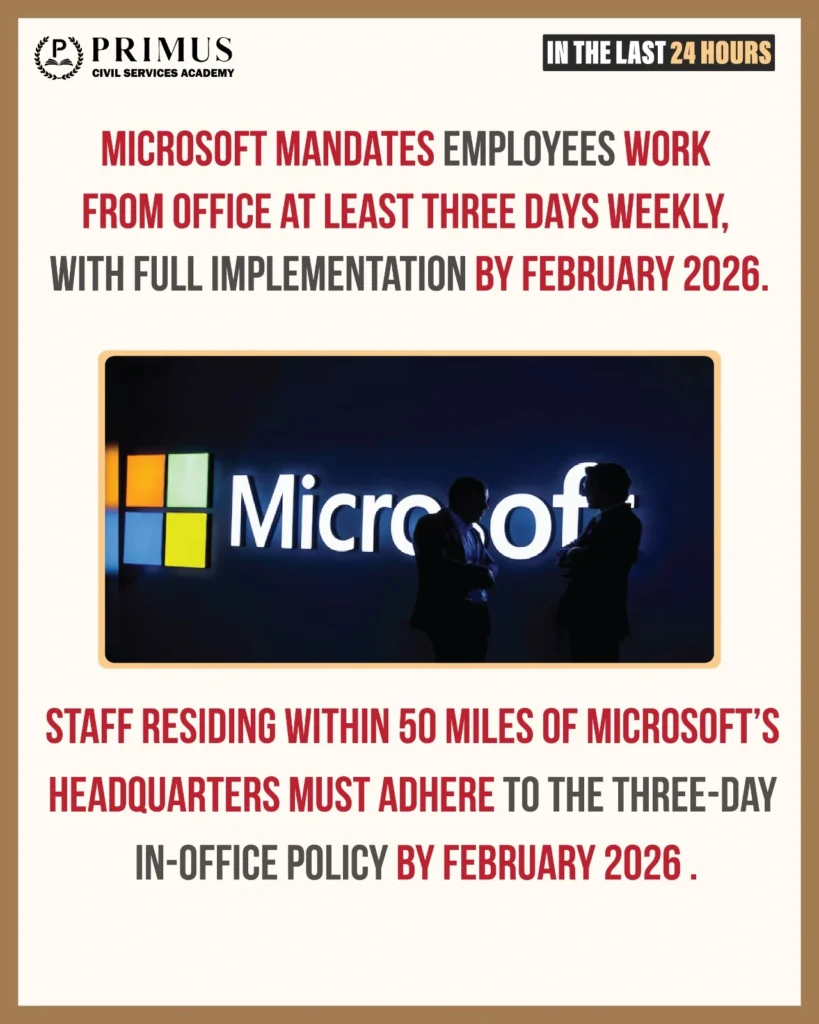
Relevance to UPSC
GS Paper 1 & 2 – Governance, Constitution, Polity, Social Justice and International relations
- Labour Policy & Employment Trends: Microsoft’s mandate for a 3-day in-office workweek reflects evolving global employment norms, pertinent to understanding shifts in work culture and labour policies.
- Corporate Governance & Employee Relations: The phased implementation strategy underscores corporate governance practices and the importance of employee engagement in policy transitions.
- Technological Impact on Work Culture: The policy highlights the intersection of technology and work culture, relevant to discussions on digital transformation and its societal implications.
More about the News
- Policy Announcement: Microsoft will require employees to work from the office at least three days a week, starting next year, with full implementation by February 2026.
- Phased Rollout: The policy will be introduced in three phases, beginning with employees near the company’s headquarters in Redmond, Washington, followed by other U.S. locations and international employees.
- Employee Expectations: Employees living within 50 miles of Microsoft’s head office will be expected to work onsite three days a week by the end of February 2026
Hybrid Work Culture
Hybrid work culture blends remote and in-office work, offering flexibility while maintaining organizational oversight. It has emerged as a response to technological advancements, changing employee expectations, and global crises like COVID-19. Going forward, it is poised to redefine work norms, productivity, and labour regulations worldwide.
Evolution of Hybrid Work Culture
- Pre-digital era: Traditional office-based work with fixed hours dominated.
- Early remote work: Telecommuting began in the 1980s with technology enabling work from home.
- COVID-19 acceleration: Pandemic forced global adoption of remote work, catalyzing hybrid models.
- Corporate adaptation: Companies like Microsoft, Google, and Infosys formalized hybrid policies post-pandemic.
- Current stage: Hybrid work integrates employee flexibility, digital collaboration tools, and periodic office presence for collaboration.
Key Trends
- Increased reliance on digital collaboration platforms (Teams, Zoom, Slack).
- Focus on work-life balance and employee well-being.
- Flexible scheduling and output-based performance metrics.
- Geographical diversity in hiring due to remote work capability.
- Rise of co-working spaces and shared offices to support hybrid employees.
Constitutional and Non-Constitutional Provisions
- Constitutional provisions: None directly; Article 21 (Right to Life) and Article 19 (Right to Practice Profession) indirectly support flexible work arrangements.
- Labour law adaptations: Factories Act, Shops & Establishment Acts may need amendments for remote work.
- Corporate regulations: Companies Act 2013 encourages corporate governance, which includes employee engagement policies adaptable to hybrid work.
Advantages of Hybrid Work Culture
- Flexibility & Work-Life Balance – Employees can manage personal and professional commitments (e.g., Microsoft’s 3-day in-office policy).
- Cost Savings – Reduced office space and utility expenses for companies (e.g., Google downsizing office space).
- Increased Productivity – Employees often perform better when allowed autonomy in work location (Infosys hybrid model).
- Talent Attraction & Retention – Ability to hire talent from different geographies (Global tech firms leveraging hybrid work).
- Environmental Benefits – Reduced commuting lowers carbon emissions (Wipro’s hybrid model contributing to corporate sustainability goals).
Impacts of Hybrid Work Culture
- Digital Transformation – Accelerates adoption of cloud-based tools and collaboration platforms (MS Teams, Zoom).
- Shift in Management Practices – Performance measured by outcomes rather than presence.
- Urban Planning & Transport – Reduced peak-hour congestion in cities like Bengaluru due to fewer office commutes.
- Employee Well-being – Better mental health and reduced burnout with flexible schedules.
- Corporate Culture Evolution – New forms of engagement, team-building, and communication norms.
Disadvantages of Hybrid Work Culture
- Reduced Team Cohesion – Less face-to-face interaction may weaken organizational culture (smaller startups facing challenges).
- Cybersecurity Risks – Remote access can expose corporate networks (increased phishing attacks in hybrid setups).
- Work-Life Blur – Difficulty separating work from personal life (reports of extended working hours).
- Inequality Among Employees – Those unable to work remotely may feel disadvantaged.
- Managerial Challenges – Supervising hybrid teams requires new skills and metrics.
Challenges of Hybrid Work Culture
- Digital Infrastructure – Reliable internet and collaboration tools are essential (rural India faces limitations).
- Policy & Legal Frameworks – Existing labour laws not fully adapted for hybrid arrangements.
- Employee Monitoring – Balancing autonomy with accountability (software monitoring debates).
- Organizational Culture – Maintaining inclusivity and engagement with dispersed teams.
- Data Privacy & Cybersecurity – Securing sensitive information across remote networks.
Government Initiatives
- Digital India Programme – Promotes internet access and digital tools for work-from-home adoption.
- e-office initiative – Encourages hybrid digital office work for government departments.
- Skill India – Upskilling employees for remote and hybrid digital operations.
Best Practices
Global:
- Microsoft – phased 3-day in-office hybrid policy with flexibility.
- Google – hybrid model with employee choice on remote days and collaboration spaces.
India:
- Infosys – hybrid work policy combining office collaboration and remote work flexibility.
- Wipro – staggered hybrid schedules with clear productivity metrics.
Way Forward
- Revise labour laws to support remote/hybrid arrangements.
- Invest in digital infrastructure for equitable access.
- Promote employee training for digital collaboration skills.
- Ensure cybersecurity protocols and data privacy measures.
- Develop performance evaluation metrics focusing on outcomes, not hours.
Hybrid work culture is reshaping modern employment, offering flexibility and efficiency while requiring robust policies and digital infrastructure. Proper adoption can enhance productivity, talent retention, and sustainability. Future governance must balance innovation with inclusivity, security, and legal safeguards.
Prelims MCQ
Q. Which of the following statements about hybrid work culture is correct?
A. It requires employees to work entirely from office locations.
B. It combines remote work with in-office presence based on organizational policies.
C. It eliminates the need for digital collaboration tools.
D. It is legally mandated under the Indian Constitution.
Hybrid work integrates remote and office work. Relies on digital tools for collaboration. Not mandated by law but supported by policies and corporate practices.
Mains Question
Q. “Discuss the evolution of hybrid work culture and its implications for governance, labour laws, and corporate management in India.”
Aishwarya Rai moves to Delhi HC seeking Protection of Personality Rights
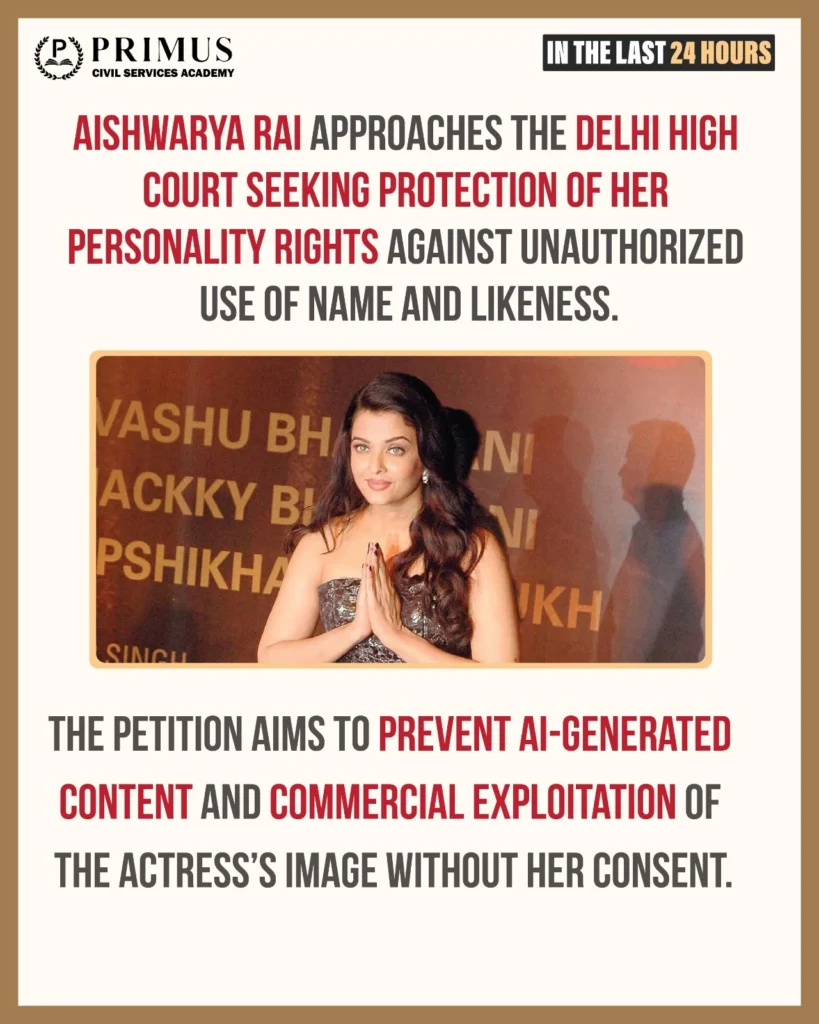
Relevance to UPSC
GS Paper II – Governance, Constitution, Polity, Social Justice & International Relations
- Digital Rights & Legal Frameworks – Highlights the need for robust legal mechanisms to safeguard individuals’ digital identities and personal attributes amid AI and deepfake technologies.
- Judicial Oversight & Fundamental Rights – Shows the judiciary’s role in protecting privacy and preventing exploitation in the digital space.
- Ethical Use of Technology – Raises issues of consent, AI misuse, and unauthorized creation or commercial use of personal content.
More about the News
- Legal Action Initiated – Aishwarya Rai Bachchan moved the Delhi HC seeking protection of her personality rights to prevent unauthorized use of her image, name, and AI-generated content.
- Court’s Preliminary Response – Justice Tejas Karia signaled readiness to issue interim orders and set the next hearing for January 15, 2026.
- Legal Grounds – Petition invokes the right to publicity, arguing that commercial use of her persona without consent is illegal.
Personality Rights
Personality rights protect an individual’s identity, image, name, and personal attributes from unauthorized commercial or public use. With the rise of digital media and AI technologies, these rights have gained prominence in safeguarding privacy and reputation. Strengthening personality rights is critical for balancing freedom of expression, technology adoption, and individual dignity.
Evolution of Personality Rights
- Origins in common law – Emerged from the right to privacy and protection against defamation.
- Early cases – Courts protected celebrities from unauthorized commercial exploitation of their images (e.g., in the US, Haelan Labs v. Topps Chewing Gum, 1953).
- Codification in India – Personality rights are derived from common law, intellectual property law, and the right to privacy under Article 21.
- Digital age expansion – Rights now cover social media, AI-generated content, deepfakes, and digital likeness.
- International recognition – Protected under laws in the US, UK, EU, and via treaties like TRIPS for commercial exploitation.
Constitutional & Non-Constitutional Provisions
- Constitutional – Articles 21 (Right to Life & Privacy) and 19(1)(a) (Freedom of Speech & Expression) indirectly support personality rights.
- Non-Constitutional – Indian Copyright Act (for image, likeness, and creative works), Indian Penal Code (for defamation, Section 499), and common law torts.
- Judicial recognition – Delhi HC, Bombay HC, and Supreme Court have upheld personality rights in landmark cases like ICICI Bank Ltd. vs. Ravindra and celebrity image misuse cases.
Advantages
- Protection of personal identity – Prevents unauthorized use of name/image (e.g., Aishwarya Rai’s HC petition).
- Commercial rights & revenue – Celebrities can monetize their image/licensing (e.g., sports personalities licensing image for endorsements).
- Privacy safeguard – Ensures control over personal data and media exposure.
- Promotes ethical media – Discourages misuse of individuals’ images in ads or digital platforms.
- Legal clarity for businesses – Provides guidelines for commercial use, reducing litigation (e.g., influencer marketing contracts).
Impacts
- Empowers individuals – Right to consent protects personal autonomy (e.g., AI-generated content restrictions).
- Deters unauthorized exploitation – Media/companies avoid misuse due to legal repercussions.
- Boosts digital content regulation – Platforms adopt policies respecting personality rights.
- Encourages celebrity branding – Controlled use of likeness enhances market value.
- Legal precedent for technology – Courts define boundaries for AI, AR, and deepfake content.
Disadvantages
- Complex enforcement – Policing digital content is challenging globally.
- Potential misuse – Can be invoked to suppress criticism or satire.
- Costly litigation – Legal recourse may be expensive for ordinary individuals.
- Ambiguity in scope – Differing interpretations of “persona” or “likeness.”
- Limits freedom of expression – Overly broad protection may conflict with press/media rights.
Challenges
- Digital proliferation – Rapid sharing on social media complicates enforcement.
- AI & Deepfakes – Synthetic media may bypass traditional IP protections.
- Jurisdictional issues – Global platforms make cross-border enforcement difficult.
- Lack of statutory clarity – India has no specific law explicitly codifying personality rights.
- Balancing rights – Ensuring freedom of expression while protecting individual dignity.
Government Initiatives
- Digital India Programme – Promotes secure digital platforms.
- IT Act 2000 & amendments – Penalizes online harassment and misuse of personal data.
- Intellectual Property Rights (IPR) framework – Supports licensing of image and likeness.
Best Practices
Global:
- US – Right of publicity laws allow celebrities to control commercial use of their image.
- EU GDPR – Provides strong personal data protection, indirectly reinforcing personality rights.
India:
- Bollywood Industry Contracts – Celebrity endorsement agreements include image use clauses.
Delhi High Court Interim Orders – Prevent unauthorized AI-generated content using celebrity likeness.
Way Forward
- Codify personality rights into specific legislation.
- Develop AI and digital content guidelines to prevent misuse.
- Strengthen judicial capacity to handle technology-related disputes.
- Promote awareness among citizens and platforms on digital rights.
- Balance freedom of expression with individual dignity.
Personality rights are crucial in the era of digital media, AI, and social platforms. Clear legal frameworks and global best practices can ensure protection while enabling innovation. A forward-looking approach balances privacy, consent, and commercial interests effectively.
Prelims MCQ
Q. Which of the following statements about personality rights in India is correct?
A. They are explicitly mentioned in the Indian Constitution.
B. They are derived from privacy, copyright law, and judicial recognition.
C. They only apply to celebrities.
D. They prevent any criticism or commentary on public figures.
Personality rights in India are not explicitly constitutional, but recognized under privacy (Art. 21), copyright, and common law. Applicable to all individuals, not just celebrities. They do not bar legitimate commentary, critique, or satire.
Mains Question
Q. “Analyse the need for codifying personality rights in India, considering global best practices and technological advancements like AI and deepfakes.”



